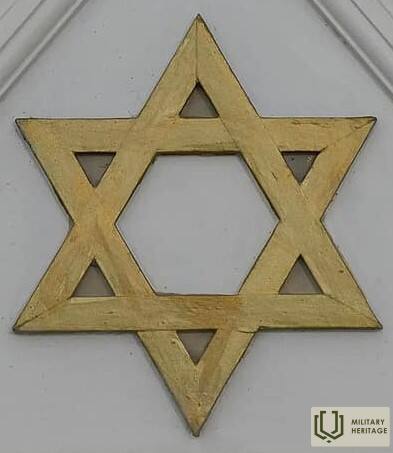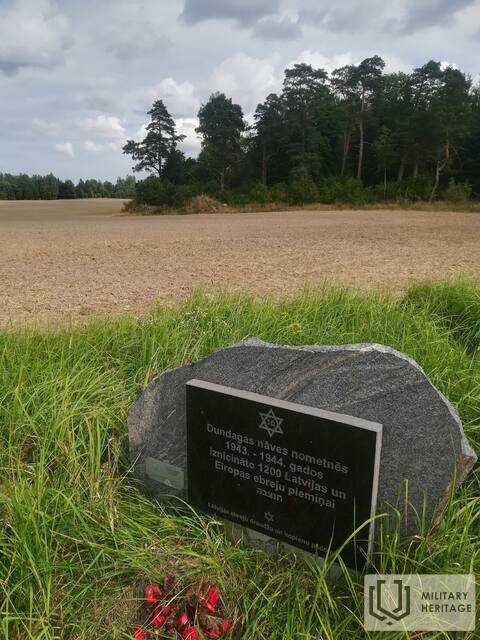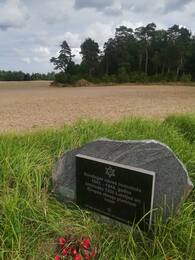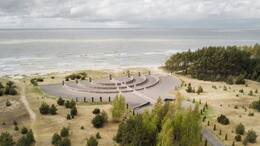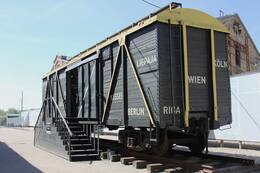Dovydo žvaigždė Dundagos koncentracijos stovyklos memorialinėje vietoje
Atgavę nepriklausomybę, Dundagos gyventojai žydų žudymo ir perlaidojimo vietoje prie Mazirbės–Dundagos kelio pastatė didelę medinę Dovydo žvaigždę, o vėliau Latvijos žydų kongregacijų ir bendruomenių taryba šalia jos taip pat atidengė atminimo akmenį.
Dundagos II koncentracijos stovykla buvo atidaryta 1943 m. lapkričio 26 d., o pirmasis jos komendantas buvo Gröschelis Maxas Ernstas. Iš pradinių 155 kalinių (1944 m.) stovykla buvo išplėsta iki 1000 kalinių. Dauguma kalinių buvo iš Rygos, Vilnios, Daugpilio ir Liepojos getų, taip pat iš getų kitose vokiečių okupuotose teritorijose. Kaliniai buvo moterys ir vaikai, kurie buvo įdarbinti sandėliuose, kareivinių statyboje, miškininkystės darbuose, geležinkelių ir bunkerių statyboje, taip pat aerodromų statyboje.
Stovykla evakuojama, kai 1944 m. liepos 24–25 d. Raudonoji armija pasiekia Tukumą. Tai vyksta geležinkeliu į Liepoją ir Ventspilį, o toliau į Štuthofo koncentracijos stovyklą.
Gräschelis taip žiauriai kankino kalinius, kad daugelis buvo mirtinai sužeisti ir mirė. Gräschelis buvo SS ir policijos teismo nuteistas už nusikaltimus, padarytus Rygos-Kaizervaldo koncentracijos stovykloje (SS stovykla Dondangenas), ir išsiųstas į Štuthofo SS ir policijos koncentracijos stovyklą Gdanzge-Mackau. Dresdeno teismas 1951 m. vasario 23 d. jam skyrė mirties bausmę, o 1951 m. birželio 23 d. įvykdyta mirties bausmė Dresdeno kalėjime.
1992 m. birželį vietos istorikės Jautrītės Freimutės iniciatyva Dundagos gyventojai Čiekurų žydų žudymo ir perlaidojimo vietoje įrengė didelę medinę Dovydo žvaigždę, kuri toje vietoje nebeišlikusi.
Tačiau 2007 m. spalį Latvijos žydų kongregacijų ir bendruomenių taryba šalia jo taip pat atidengė atminimo akmenį su dviem Dovydo žvaigždėmis ir užrašu latvių kalba: „1200 Latvijos ir Europos žydų, sunaikintų Dundagos mirties stovyklose 1943–1944 m., atminimui“. Paminklo atidengime dalyvavo Latvijos žydų kongregacijų ir bendruomenių tarybos, vyriausybės ir vietos valdžios atstovai, taip pat Vokietijos, Izraelio, Slovakijos, Čekijos, Austrijos ir Vengrijos ambasadų atstovai.
http://www.tenhumbergreinhard.de/1933-1945-lager-1/1933-1945-lager-d/dundaga-ii-dondangen.html
Susijusi laiko juosta
Susijusios vietos
Liepojos Holokausto aukų memorialas
Didžiausias Holokausto aukų memorialas Latvijoje yra Liepojoje, Šķēdės kopose. Memorialas skirtas daugiau nei 3000 Liepojos žydų, nužudytų Antrojo pasaulinio karo metu, atminimui. Jis yra Izraelio nacionalinio simbolio – septynšakės žvakidės, vadinamos menora, – formos. Memorialo kontūrai, aiškiai matomi iš paukščio skrydžio, sudaryti iš skaldytų riedulių ir granito luitų. Menoros „šviesos“ – tai granito stulpai su Jeremijo raudų eilučių užrašais hebrajų, anglų, latvių ir rusų kalbomis.
Rygos getas ir Latvijos Holokausto muziejus
Rygos geto ir Latvijos Holokausto muziejus yra įsikūręs Rygoje, netoli Rygos centrinio turgaus ir Rygos centrinės stoties. Muziejus buvo atidarytas 2010 m. toje vietoje, kur anksčiau buvo miesto sandėliai. Jis įsikūręs istorinėje miesto dalyje, šalia buvusio žydų geto sienos. Geto teritorija yra unikali, nes architektūros požiūriu ji nepasikeitė nuo Antrojo pasaulinio karo. Tai memorialas, skirtas žydų tautos tragedijai. Vokietijos politika žydų gyventojų atžvilgiu Latvijoje iki 1939 m. pabaigos buvo tokia, kad Vokietijos diplomatai ir politikai bandė daryti spaudimą Latvijos vyriausybei, kad ši imtųsi veiksmų prieš žydus, apribodama jų laisvę. Po Baltijos vokiečių emigracijos 1939 m. Vokietijos ambasada nebeturėjo tokios geros prieigos prie informacijos apie gyventojų nuotaikas ir įvykius Latvijoje kaip anksčiau. Kai Raudonoji armija okupavo Latviją, ji manipuliavo visuomene, kad gautų žydų gyventojų paramą naujajai okupacinei valdžiai. Tačiau po to, kai režimas pradėjo represijas prieš visą visuomenę, parama sparčiai sumažėjo. Dėl viso to tarp žmonių susiformavo gilus susiskaldymas. Vėliau kitas režimas – Vokietija – bandė tuo pasinaudoti. Jie tikėjosi, kad vietos gyventojai persekios ir puls žydus, tačiau taip neatsitiko. Taigi, Vokietija pakoregavo savo požiūrį ir parengė naują planą – iš pradžių įkurti žydų getą, o vėliau sunaikinti jo gyventojus.




